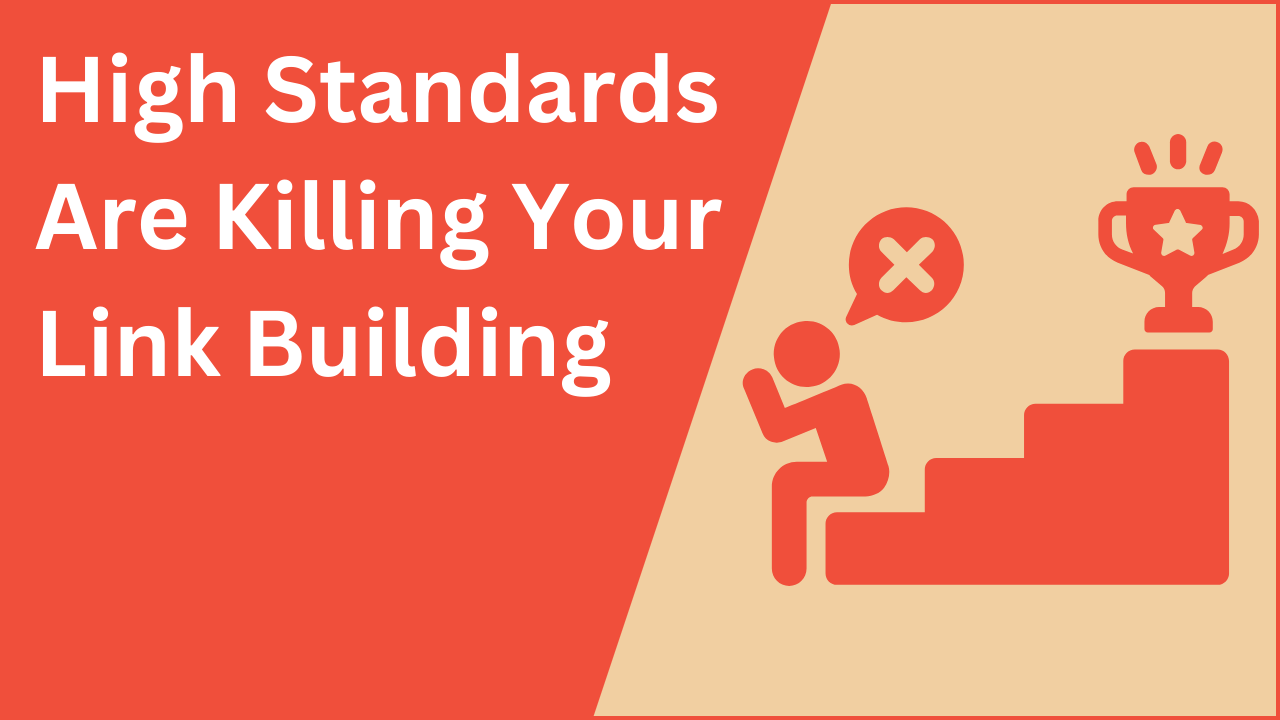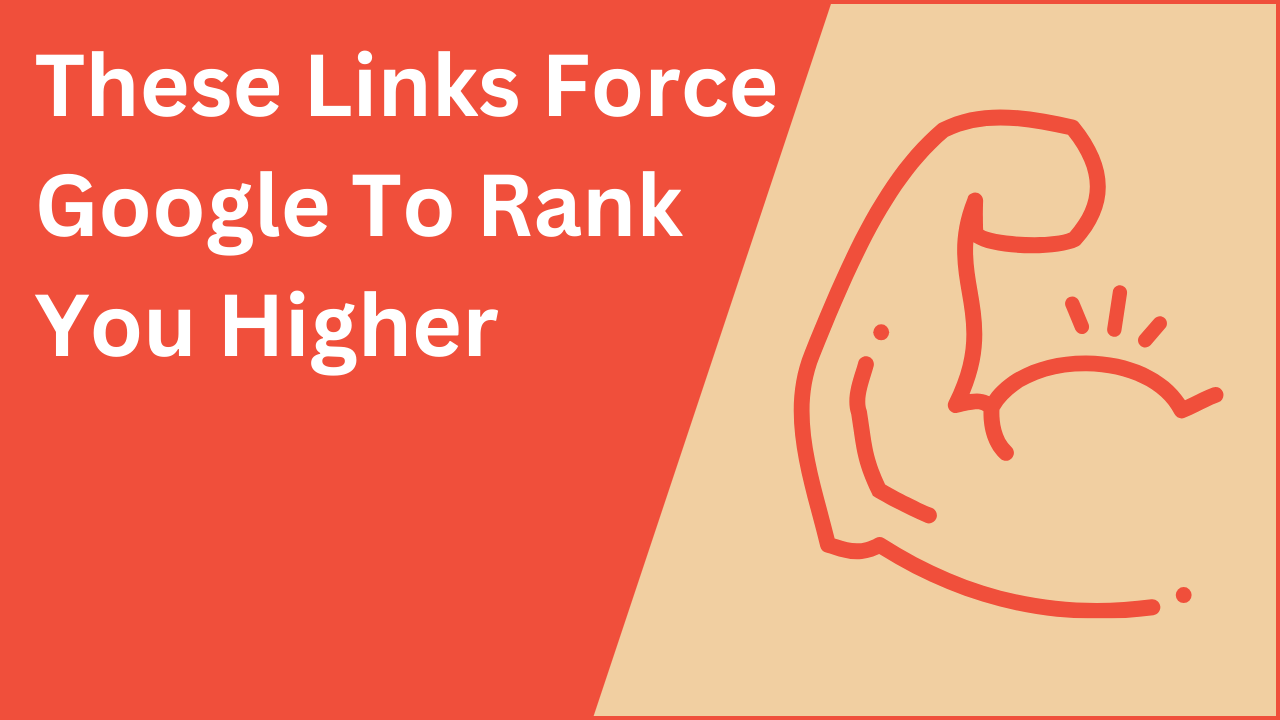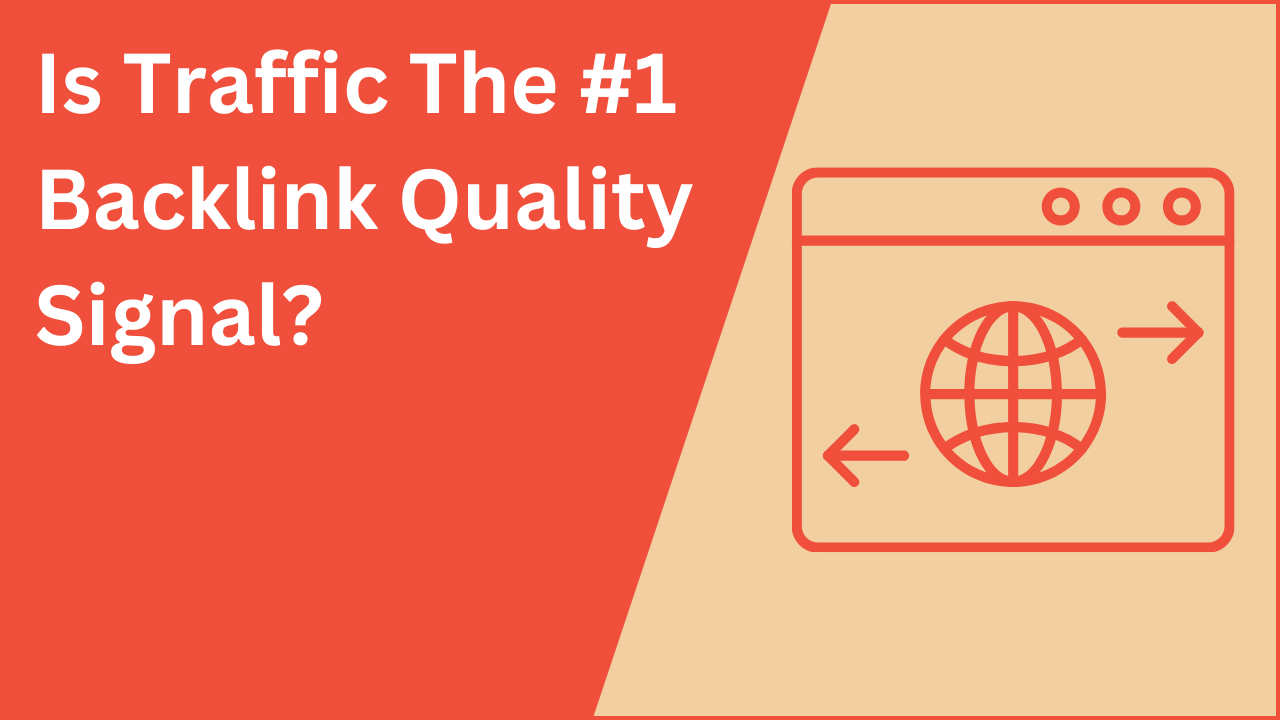Every SEO understands the importance of backlinks, but how does the authority of a link impact its worth?
Are links with a higher DA more valuable? General knowledge would say yes. But, it’s not always that simple.
Having a rinse and repeat strategy for getting high authority backlinks can help you increase your site’s authority while also pushing you higher in the search engine.
The goal of this guide is to help you develop your link building skills and fabricate a plan that you can use to win more high quality backlinks consistently.
What Are High Authority Backlinks?
The first thing you need to understand is what high authority backlinks are and how they can positively impact your rankings.
How is a Website Considered “High Authority”?
A high authority backlink is generally any link from a site with a domain authority of 70 or higher.
Of course, we want to take this with a grain of salt because Google doesn’t create domain authority scores.
Google uses a much different and more complicated algorithm in the search engines to determine PageRank (PR).
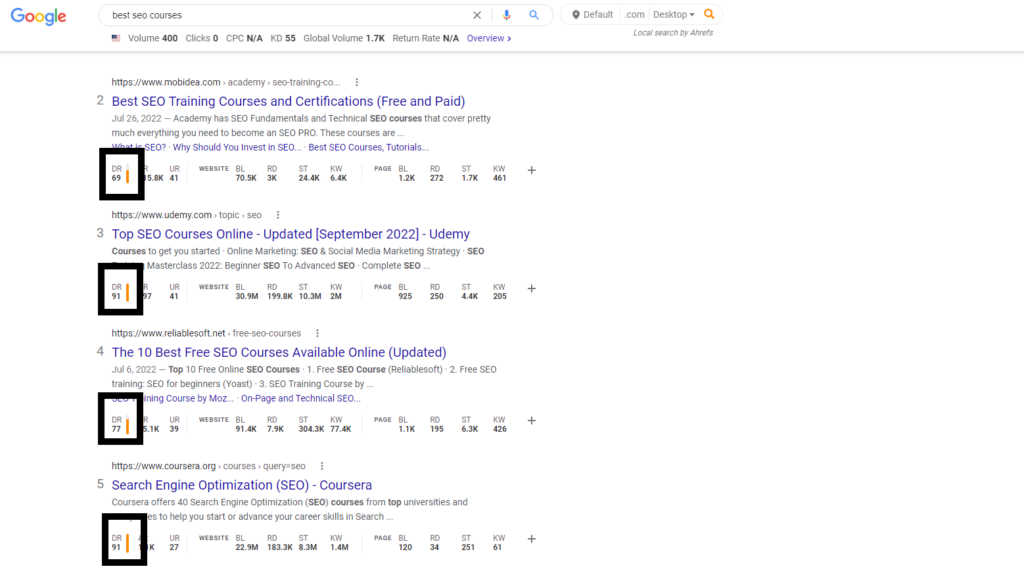
The image above of the search engines proves that domain authority isn’t the “end all be all” that determines high authority backlinks.
The example uses domain rating, a metric provided by Ahrefs but essentially the same as domain authority from Moz.
These are positions 2-4 on Google for the phrase “best seo courses.”
Udemy has a lot of authority in this space, yet a lower 69 DR website ranks higher. If we took domain rating at face value, we could assume that the higher score would automatically rank higher, but that isn’t always the case.
So, what makes a high authority backlink then?
We think that the quality and relevancy of a site paired with a high domain authority could determine the authority of a link.
Truthfully, there are a lot of high DA websites that are complete junk. They don’t have any organic traffic, they rank for nothing, yet they still have a high score. These are called link farms.
You want to ensure you build links from high authority sites that Google trusts. If Google sees that trustworthy websites are linking to you, the chances of Google trusting you increases, and so does your domain authority.
Low quality websites will only hurt your SEO strategy and make it harder for your page to rank even if you get links..
How to Build High Authority Links
As a link building service we’ve seen over and over again that getting high authority backlinks is one of the most critical factors determining where your website ranks in the search engine.
Knowing how to score quality links the right way is incredibly valuable.
We want to break this down into a few actionable steps that you can take in your content to earn more high authority links.
Create Great Content
It all starts and ends with great content. If your site is incredibly new and doesn’t have any content on it, no one will want to link to your website because there’s nothing in it for them.
You also want to ensure that the content you have is worth something. Are you doing anything different on your website that stands out? If not, you may have a hard time standing out when you go to pitch prospects for links.
Another key to creating content people want to link to is relevancy; we’ll be using this word a lot. Having relevant content in the search engines is a great way to get backlinks.
If you have a real estate website and plan to pitch other real estate websites in exchange for links, you need great information about the subject.
The value you provide on your sites needs to further enhance the experience on the recipient’s site.
We want to open up a new site explorer in Ahrefs and input that domain.
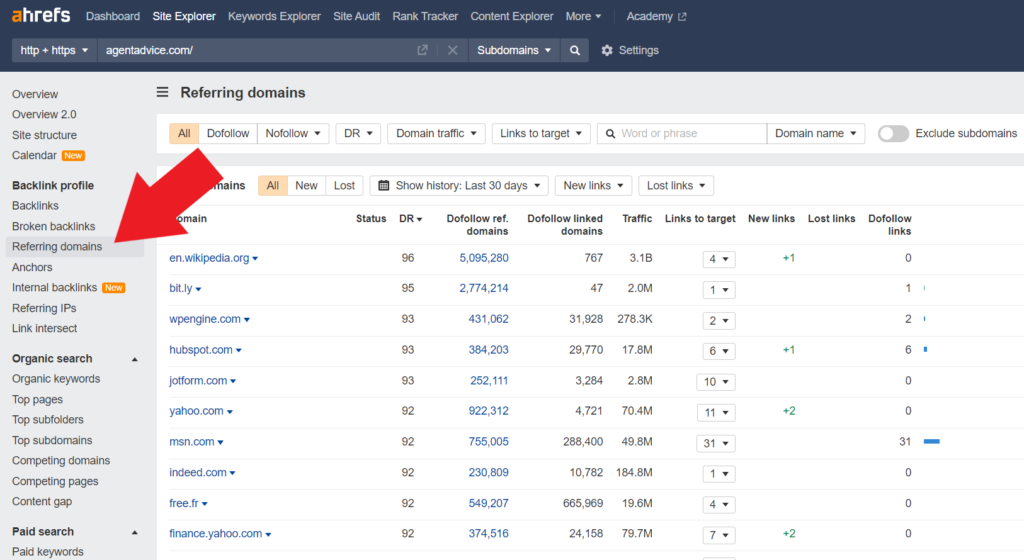
Click referring domains in the left column to bring up a list of all the domains linking to your competitor.
As you can tell, there are a lot of domains you’ll:
1. Never be able to pitch
2. Never be able to earn a link from
3. Never want a link from
So, you need to filter the results to find the domains you’d actually want to send email pitches to.
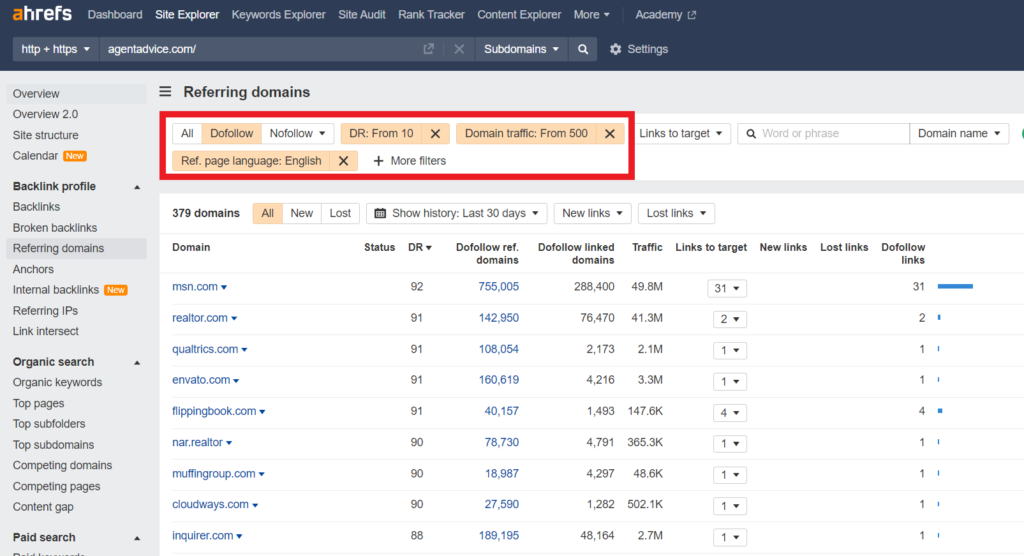
These filters narrow the results down to English dofollow links on high authority sites with a DR of 10 or higher and 500 traffic.
You can export this list into a spreadsheet and start figuring out which domains you want to reach out to first.
One last filter we think is helpful is filtering by “new” domains only.
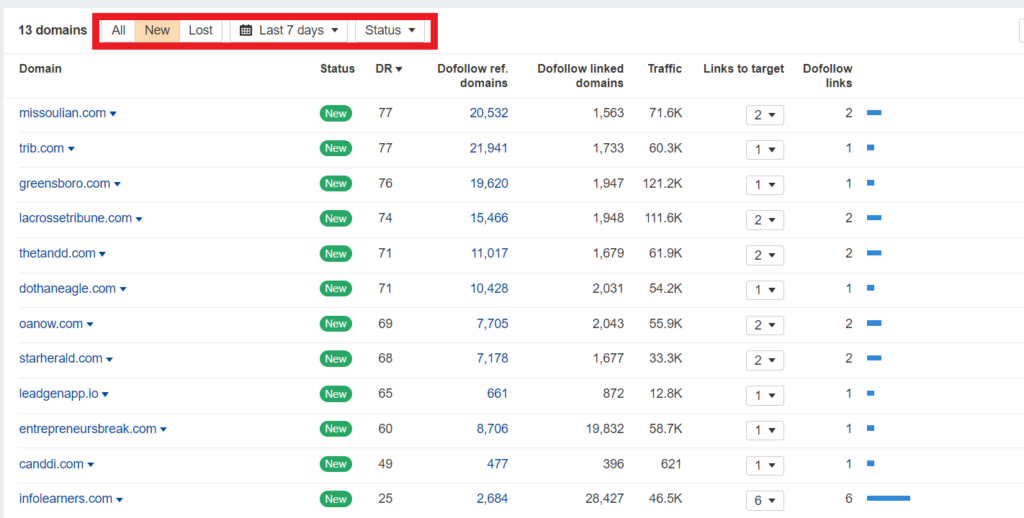
If you filter by new domains added in the last seven days, it shows you all the most recently added links.
This is extremely valuable because it shows you what domains are actively offering links. If they help build backlinks to these high authority sites, you can imagine they’d be willing to respond to you and give you a link if you provide enough value and have a high authority site.
Build a Prospect List
You have a high authority site loaded with amazingly valuable content; now what?
It’s time to compile a list of prospects that you can reach out to and ask for a link.
One of the most effective ways of doing this is by looking for relevant sites and competing domains to see what sites give them backlinks.
Make a List of Competitors
You’ll start by finding out the top ranking pages for the search phrase you’re trying to get backlinks for.
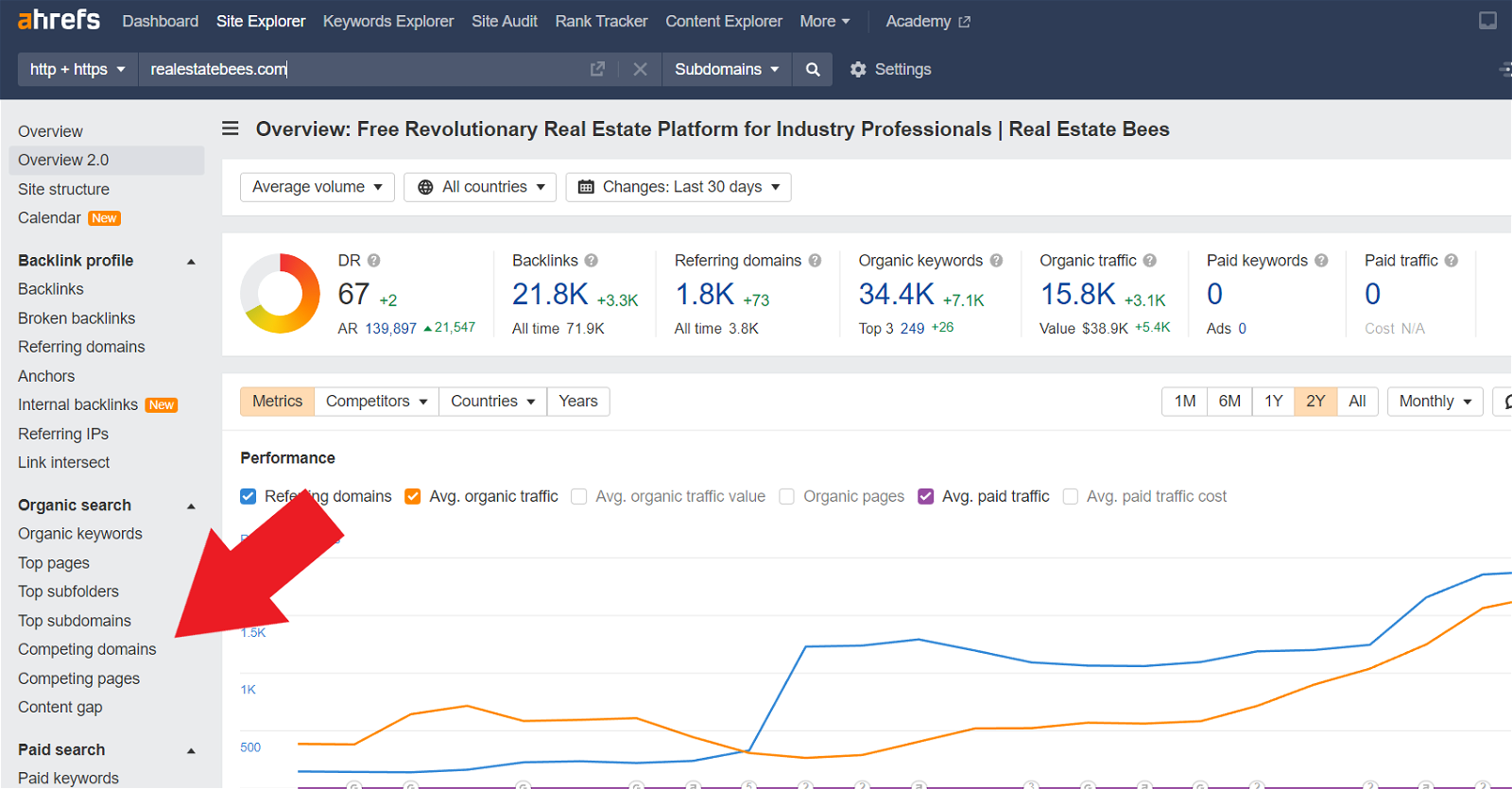
For this example, I used a real estate marketing resource company called realestatebees.com.
In Ahrefs, click competing domains.
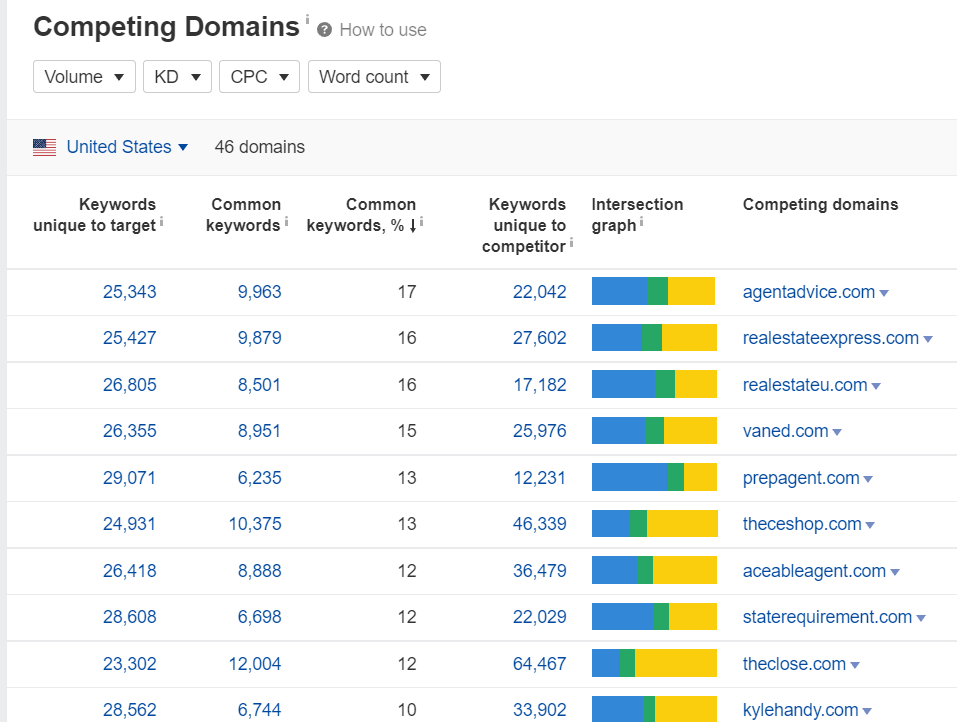
You’ll get a list of the domains that share common keywords with you and unique keywords they’re targeting that you’re not.
These keywords are in blog posts and on various pages of the website. These sites likely have quality content because they have a number of quality links.This is a great way to find authority websites.
Let’s take the top one, agentadvice.com, and see what sites link back to them. We can get a direct snapshot of their link profile in Ahrefs.
Keep in mind that if the backlinks are low quality, you still don’t want them. You want to focus on quality links.

Pitch Prospects & Provide Value
Once you’ve built out your list of prospects and you know who you want to reach out to, it’s time to determine your approach for getting backlinks.
Offering Value
You want to approach every interaction like you’re closing a sale. You can’t just offer them a piece of content and say:
“Hey, I’ve got this great piece of content; it’s incredibly valuable, packed with information, and helpful for your readers. Would you be willing to link to it”?
This link building strategy might have worked in 2008, but it does not work today. You must separate yourself from the competition by providing more value than anyone else.
It’s important to understand that many companies won’t even give you a link in exchange for money because they’re not going to waiver from their standard procedure just because you offered them $100.
You need to do more. You have two primary options.
Truly Awesome Guest Posting
A piece of content can be deemed valuable when it helps push the other websites towards its SEO goals. Often, we write guest posts with a self-centered mentality.
We’re writing guest posts because we need links to a certain page, so we want to make sure it’s relevant, with the right anchor text, and published promptly. These are all self-centered factors and will not help you get links.
Look at the style and topics on the sites you’re pitching and pitch them something that enhances what they’re already doing. This is how you get links.
Better yet, ask them what topics they want. Find out what topics benefit their SEO and their website.
Ask them how you can support their SEO efforts. Pitch them as if you’re an up-and-coming writer and you’re simply looking for exposure. It takes the focus away from link building.
Offering content in this manner shows that you want to support their business and help them reach their goals. You’re not just focused on getting high authority backlinks.
You can also include internal links to other articles on their page and do a bit of keyword research ahead of time to see if you can get the page to rank for non-competing keywords.
This is also beneficial for you because you’re sending that traffic to a page with your link on it. It looks good for Google search but also increases the chances of sending traffic to your page.
Last but not least, offer media, graphics, and illustrations too. If you’re an expert in your field, you should be able to obtain useful images that enhance the content and provide more value.
Doing all of these things while having high authority websites, quality content, and a good overall digital marketing strategy can increase your chances of getting authority backlinks.
Make sure you’re crystal clear in your link building pitch about your intentions.
3-Way Link Exchanges
Link exchanges are the way of the future and are one of the most powerful link building strategies out there.
In a link exchange, the person you’re pitching is not just getting a link or money from you, they’re getting another great link in exchange for one.
Why link building exchanges are so powerful
Don’t always assume that the people you’re reaching out to don’t understand SEO. Many companies now have SEO specialists who understand the value of a great link.
In a link building exchange you’ll reach out to a number of websites offering to get them high authority backlinks from another site.
When you get a response from three sites you can have site 3 link to site 2, who links to site 1, who links to you. Essentially, you’re just creating a web of links and multiple opportunities for links.
The reason this is easier to get someone to agree to is because it’s not just a 1 to 1 exchange of links.
Having too many direct exchanges looks weird to Google and this helps you develop relationships that you can call upon again in the future when you need links.
The 3 way link exchange works for a guest blog post as well.
If you do a guest post, link to a prospect in the post who then will link to you in exchange. Now you earned two links for one guest posting opportunity.
The more you do this, the more sustainable your SEO becomes as you continue to nurture relationships and build a long list of high authority sites you can get backlinks to and from. The key is to stay organized and keep a sheet of all the sites you’ve had contact with so you can call reach back out in the future.
The Pitch
You’ve got your list of prospects, you have multiple methods to build backlinks, now it’s time to start actually reaching out and pitching for high authority backlinks to help your page in Google search.
Find The Best Contact
If you’re trying to get a post on a website, pitching the HR Manager or random bloggers and journalists isn’t going to help your SEO very much. You need to find the right person on a high DA site to earn a backlink.
You need to find the decision maker or person in charge of actually agreeing to the guest post, link exchange, etc. There are a few methods you can use to search for the right contact on a website.
Hunter.io
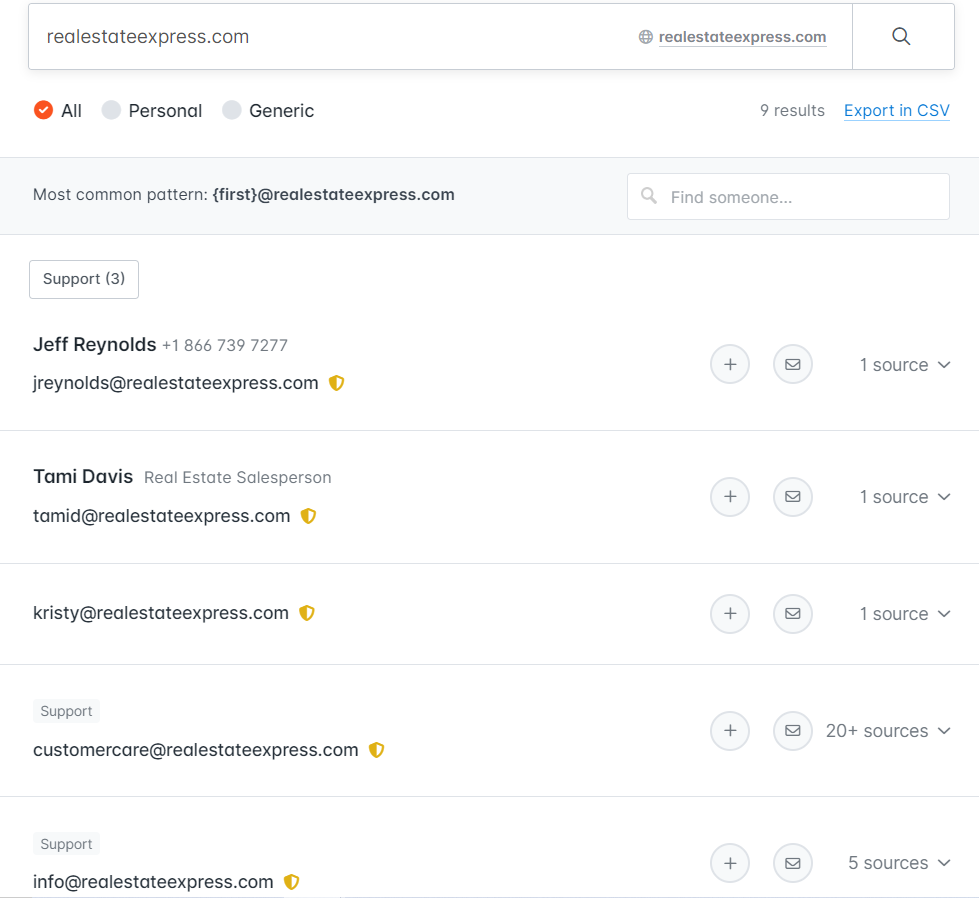
Hunter.io is a data scraping resource that goes into a website and pulls out whatever contact information it can find.
In the example above, it scraped a real estate education site called realestateexpress.com and found a number of emails and contacts on a page.
Another great thing about the tool is that it provides you insight into how they structure their emails. I.e firstname.lastinitial@website.com or firstinitial.lastname@website.com, etc.
In some cases it will even tell you their title at the company. If you can find anything to do with internet marketing, content, SEO, or marketing, you’re good to go.
LinkedIn Sales Navigator
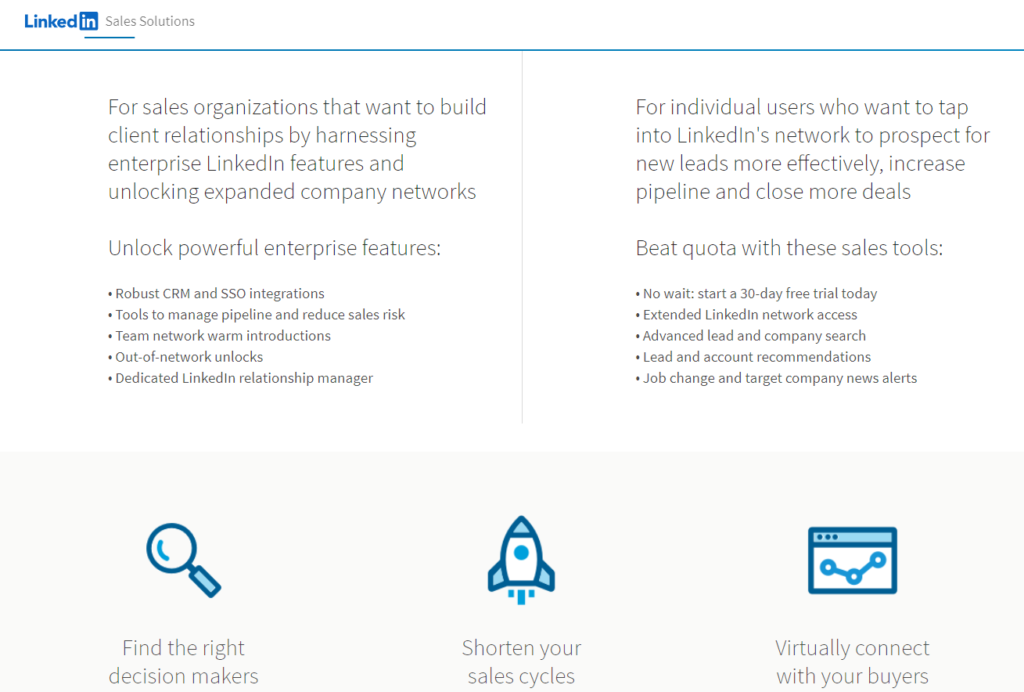
The sales navigator is a sales intelligence platform designed to help build B2B relationships using information that is already on LinkedIn.
This is useful if you need to find the contact information of marketing professionals so you can pitch them on a guest post off their website.
Sales Navigator also provides its own outreach and messaging platform which we feel really eliminates a barrier of trust because people are more willing to communicate on LinkedIn compared to email.
For the most popular Sales Navigator Core Plan, it’s not cheap. It’s $79.99 per month if you bill annually. They do offer a free seven day trial so you can test it out..
Send a Cold Pitch
You found a potential marketing professional’s contact information and you’re ready to send your first pitch.
Your cold email should have three primary objectives:
- Get their attention
- Build trust
- Ask them to do something
A great way to get their attention is through personalization. This shows them that you’re not just another bulk scammer.
You could mention that you liked an SEO article they recently published… but this has been overdone lately.
A great strategy is to go back to the SEO tool Ahrefs using the backlink analysis section on their site and talk about a recent link they scored.
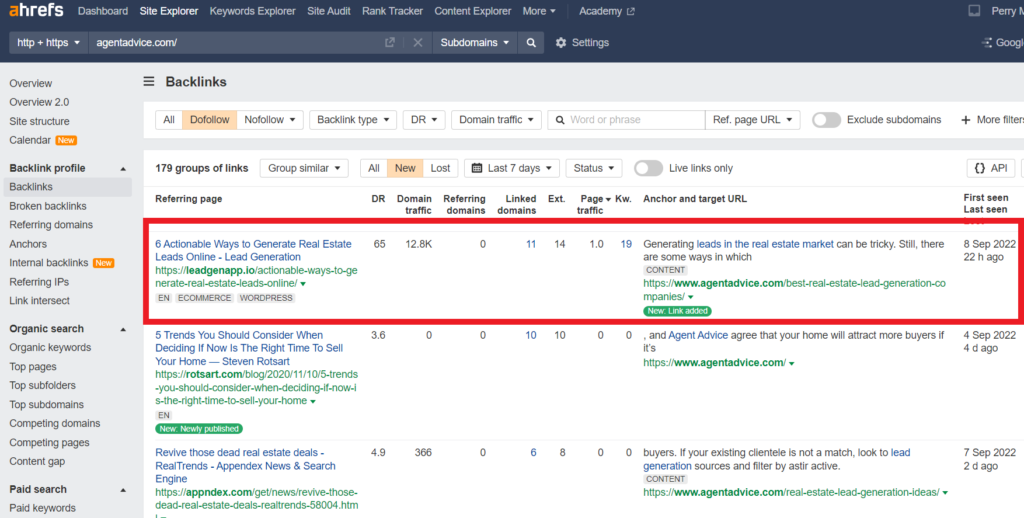
This is a great link that our example won only a day before writing this article. Imagine pitching someone on something so relevant and recent, it would immediately get their attention because it’s so fresh in their mind.
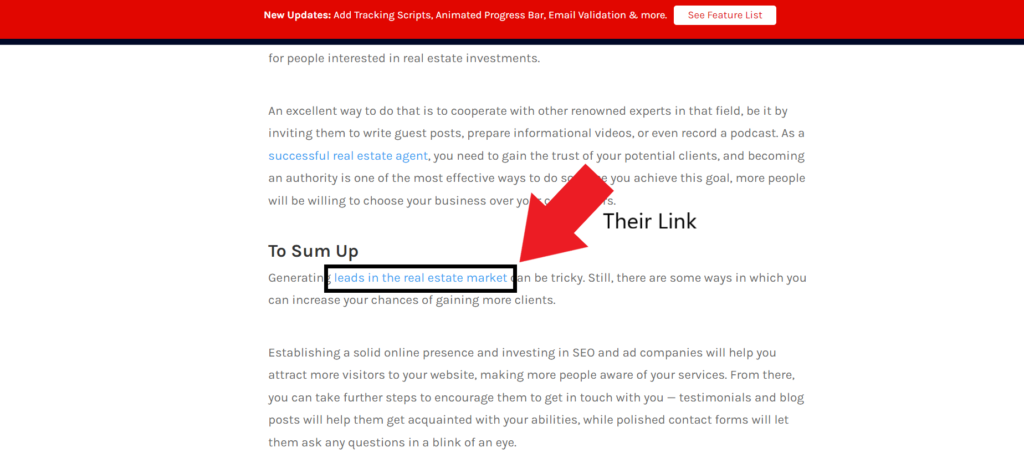
You can head over to the website where the link is, take a screenshot, and include it in the email.
Congratulate them on scoring such an awesome link on their website. This will show that you’ve spent a solid amount of time researching them. Doing so will build trust and make them want to continue reading.
Only say what is absolutely necessary and ask for a link as soon as possible using whatever method you plan to use.
Email Writing Tip
Make sure you keep the email short and concise. Only say what is absolutely necessary and get to “the ask” as soon as possible to get the backlinks.
Once you’ve built a little trust, it’s time to tell them why you’re actually in their inbox. Convey that this is a method you use to get quality backlinks but you intend on offering plenty of value in return. Pitch your guest post or link exchange depending on the prospect but only focus on one.
End with a direct call to action. Ask them to reply with the topics they’d like and make it as easy as possible to move onto the next step.
The key is to leave the email open by asking them a question. Many studies show that this increases the chances of getting a response.
Send a Few Follow Ups
Don’t always expect to get a response from your first email. The general average response rate on cold email is somewhere around 3%. Doing some of the things mentioned in this guide can help increase your rate.
Email 1: Initial Pitch
The first email is your pitch which we’ve covered above. Get their attention, build trust, be clear and concise, and make sure to come across as an expert in your field that wants to provide value.
Email 2: “Hey, did you see my first email”? Bump
The second email is simply a bump of the first. You’re not saying anything new or adding anything, you’re simply pushing the email to the top of their inbox in case they didn’t see it or they read it at a bad time and forgot to respond.
Email 3: Back Up Pitch
If they don’t respond to the bump you’ll want to give them some options. Perhaps the guest post wasn’t the right pitch for them so you could try a link exchange. Ask what suits them better and allow them to make the decision now.
Email 4: Back Up Pitch Bump
Your last email should be a final bump of the back up pitch. You just want to push it to the top of their inbox again. Now may be a good time to say that you’re going to leave them alone after this email as well because too many cold emails can get frustrating for someone who isn’t interested.

